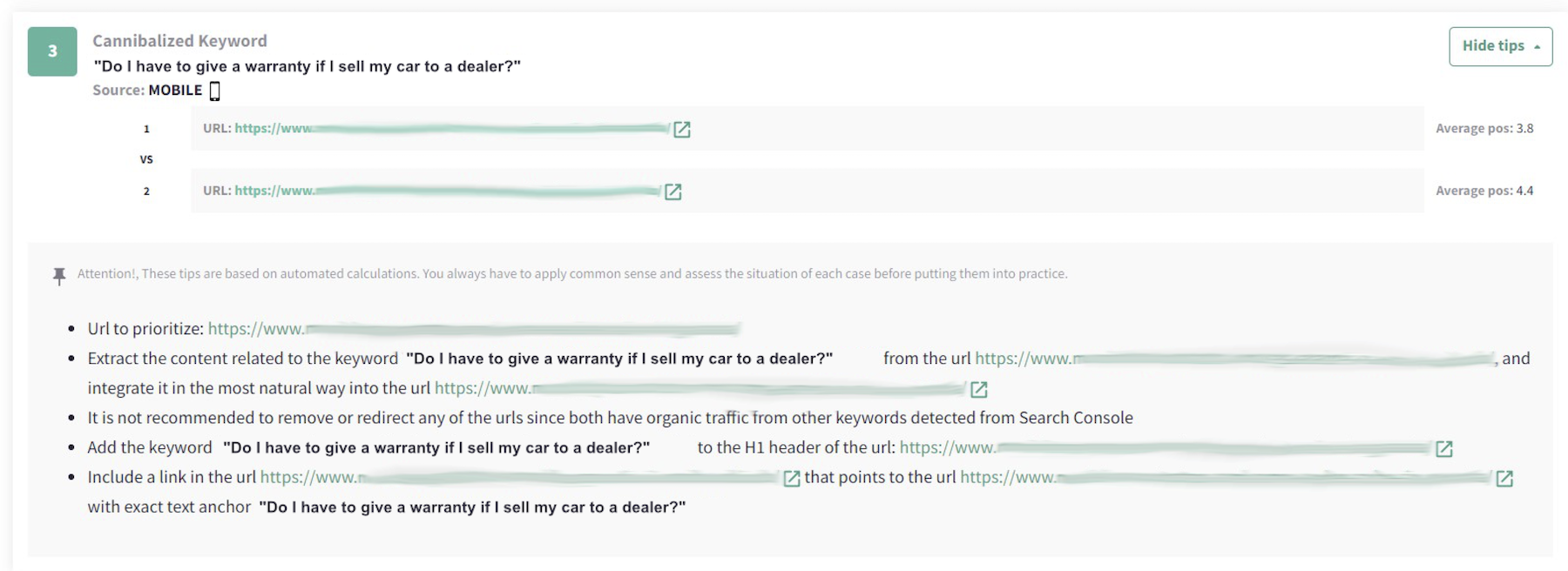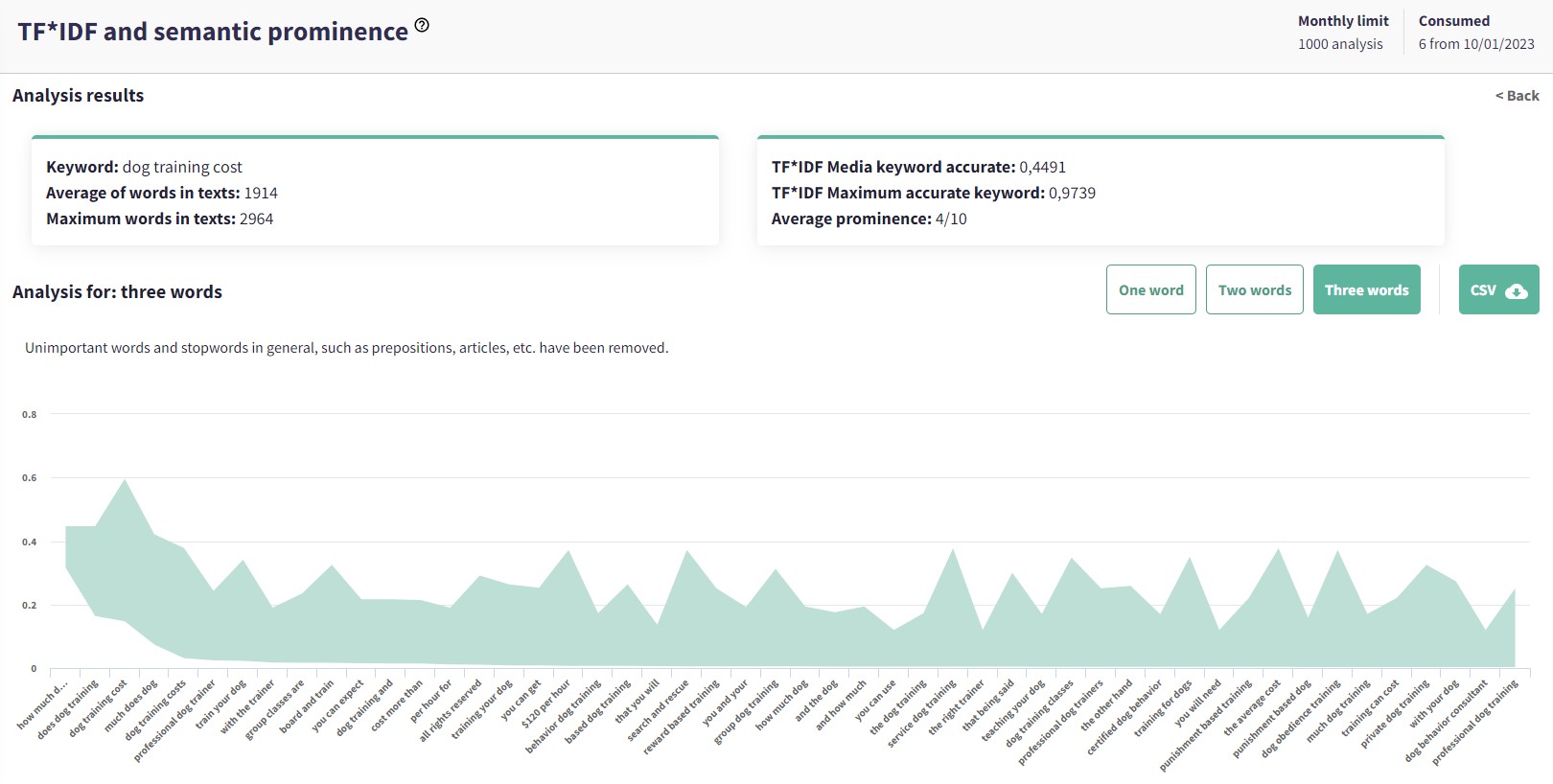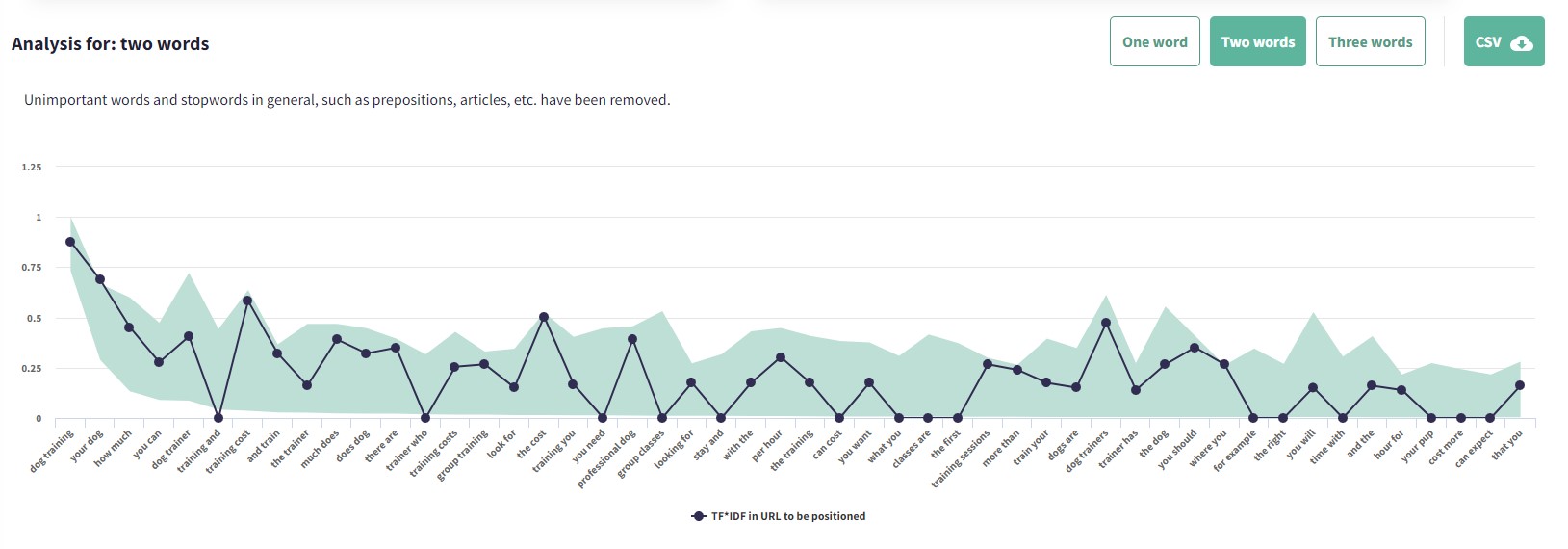SEO
How To Get More Traffic By Fixing Keyword Cannibalizations

This post was sponsored by DinoRANK. The opinions expressed in this article are the sponsor’s own.
Google is a great source of qualified and recurring traffic for your business – that’s a fact.
Many people say that the key to SEO success is to establish yourself as an authoritative source for all the keywords in your industry, even niche keywords.
Unfortunately, your competition is doing the same thing. In some cases, you may even be competing with yourself.
Everyone is creating the same content to rank high on Google. So, you need to set yourself apart.
Your competition may be using the same niche keywords as you, but are they optimizing their domain’s SEO by cleaning up cannibalized content and keyword cannibalization?
They may not be; so, this is a great way to propel your website to the top of Google.
What Is Keyword Cannibalization In SEO?
As you may know, sometimes two or more URLs on the same domain may rank for the same keyword or group of keywords.
When this happens, Google does not know which piece of content to show on search engine results pages (SERPs).
When these URLs compete for the same search terms, it is called SEO cannibalization.
How Cleaning Up Cannibalization Can Instantly Boost Your Rankings
When you and your competition are ranking for the same keywords, yet your position on SERPs is lower, you may have a cannibalization issue.
If your content is cannibalizing itself, you not only have to fight your competitors for a top position – you also have to fight your own pages.
There’s enough competition out there without having it at home, right?
Cannibalization is a detrimental factor when URLs compete with each other. They can even harm your domain authority if there are too many of them, especially if you haven’t told Google that there is a clear difference between two similar pieces of content.
As you can see, cannibalizations have a negative influence on your domain’s SEO.
To solve the cannibalization problem, we must first know how to find them.
How To Find Cannibalization On Your Website
There are different ways to find cannibalization on your domain:
- The Manual Way
- The Easy Way
How To Find Cannibalized Keywords By Hand
There are two ways to locate content and keyword cannibalization without using a tool:
- Use a rank tracker or Google Search Console to see which positions your pages are ranking in the search results, as well as the keywords they are ranking for; then, find matching URLs for the same keywords.
- Review your site’s content manually to see if there are several pages that address the same topic or include the same keywords. Then, go to Google and search for that keyword you suspect you are cannibalizing and check if you really do it or not; this can also help you prevent it from happening.
How To Locate Keyword Cannibalization With A Single Click
Using DinoRANK, you can simply click one button and instantly see all your cannibalized content.
All you’ll need to do is create a project in the tool, and sync it with your Google Analytics and Google Search Console account. DinoRANK does the rest.
See what content is cannibalized on your website now →
Now, once you have located all the cannibalizations that affect your website, what decision should you make?
What Is The Best Way To Fix Cannibalization?
Once you have found the cannibalizations on your website, you can take these steps to solve the problem:
- Join or merge two URLs into one.
- Make a 301 redirect.
- Make a shift in focus to one of the two contents and de-optimize or optimize for the word that it cannibalizes.
- Place a canonical tag in one of the two URLs.
- Remove one of the two contents if you consider it thin content or duplicate content.
How Do I Pick The Best Method?
What analysis should you do when facing cannibalization to perform the most optimal action?
Let’s say that you have 2 URLs of the same domain that are positioned for the same keyword; 1 URL is in position 5, and the other URL is in position 7 on the SERPs.
In this case, you should:
- Check the content of both pages to see if they are addressing the same topic or include the same keywords. If so, they are probably competing with each other and causing cannibalization.
- Review the page authority of each page, as measured by the number of inbound links, quality of links, site structure, etc. The page with higher authority will likely perform better in search results.
- Check the traffic received by each page to see which one is receiving more visits, and analyze which URL is responding better to the search intention of that or those keywords.
- Check the conversion rates of each page to see which is generating more sales or conversion actions.
Once the analysis is done, you will have enough elements to recognize what action you should take in each cannibalization.
Still not sure?
Don’t worry. DinoRANK will show you recommendations on how to proceed, depending on the case.
 Screenshot from DinoRANK.com, January 2023
Screenshot from DinoRANK.com, January 2023Usually, content is consolidated into one of the two cannibalized URLs (the one with higher authority or higher traffic), and the discarded URL should become a 301 redirect.
The impact of this repair is usually positive in a very high number of cases.
Although if both contents fulfill their function (for example, one URL belongs to the product card and the other to a blog post), a better option would be to optimize or de-optimize the content as appropriate or choose to implement a canonical tag to one of the URLs to indicate to search engines which is the main page.
In any case, it is important to continuously monitor the performance of the pages and make adjustments if necessary to avoid cannibalization in the future; with DinoRANK you will have this under control.
How To Optimize Or De-Optimize Content That Is Cannibalizing
Search engines use algorithms to determine the relevance of a web page for a given search query, and one of the ways they do this is by identifying the keywords that appear most frequently on a page, relative to the keywords that appear on other similar pages.
Before optimizing or de-optimizing one of the two contents, it’s important to know all the keywords for each URL being cannibalized.
Then, you’ll need to analyze their semantic content with TF*IDF analysis.
So, analyzing a URL whose content you want to optimize/promote for a specific keyword with TF*IDF will allow you to understand which keywords are relevant to that content.
-
 Screenshot from DinoRANK.com, January 2023
Screenshot from DinoRANK.com, January 2023
Expanding and semantically optimizing content that is already ranking highly, whether it is cannibalizing or not, is one of the best ways to gain more relevance for those terms that only received impressions or a few clicks. This is because you are now providing a greater semantic richness to that content.
With DinoRANK, you can use TF*IDF analysis on already published URLs to see how to optimize them.
You can also use this feature when you want to create new content based on a keyword or a group of keywords you want to rank for.
-
 Screenshot from DinoRANK.com, January 2023
Screenshot from DinoRANK.com, January 2023
DinoRANK arranges the information visually, separating the graph into three filter layers: one keyword, two keywords, and three keywords.
-
 Screenshot from DinoRANK.com, January 2023
Screenshot from DinoRANK.com, January 2023
In addition to the recommendations, you will also be able to quickly see the header structure used by your most direct competitors in Google’s Top 10.
In a very short time, you’ll discover opportunities and content ideas with an optimal heading structure, including the related semantic keywords needed to rank.
If, in addition, this semantic content extension is complemented by some internal links to that optimized URL, and you do it with anchor text of the primary keyword or exact semantic keywords, you will strengthen the authority and the typicality of that URL you want to promote.
With internal links, you derive a greater semantic context and strengthen the authority of that page already optimized, thanks to the semantic prominence analysis TF*IDF.
If you want to use these features to work the SEO of your projects in a simple but effective way, you can try DinoRANK.
All the SEO your website needs can be found in DinoRANK.
SEO
Google Further Postpones Third-Party Cookie Deprecation In Chrome

Google has again delayed its plan to phase out third-party cookies in the Chrome web browser. The latest postponement comes after ongoing challenges in reconciling feedback from industry stakeholders and regulators.
The announcement was made in Google and the UK’s Competition and Markets Authority (CMA) joint quarterly report on the Privacy Sandbox initiative, scheduled for release on April 26.
Chrome’s Third-Party Cookie Phaseout Pushed To 2025
Google states it “will not complete third-party cookie deprecation during the second half of Q4” this year as planned.
Instead, the tech giant aims to begin deprecating third-party cookies in Chrome “starting early next year,” assuming an agreement can be reached with the CMA and the UK’s Information Commissioner’s Office (ICO).
The statement reads:
“We recognize that there are ongoing challenges related to reconciling divergent feedback from the industry, regulators and developers, and will continue to engage closely with the entire ecosystem. It’s also critical that the CMA has sufficient time to review all evidence, including results from industry tests, which the CMA has asked market participants to provide by the end of June.”
Continued Engagement With Regulators
Google reiterated its commitment to “engaging closely with the CMA and ICO” throughout the process and hopes to conclude discussions this year.
This marks the third delay to Google’s plan to deprecate third-party cookies, initially aiming for a Q3 2023 phaseout before pushing it back to late 2024.
The postponements reflect the challenges in transitioning away from cross-site user tracking while balancing privacy and advertiser interests.
Transition Period & Impact
In January, Chrome began restricting third-party cookie access for 1% of users globally. This percentage was expected to gradually increase until 100% of users were covered by Q3 2024.
However, the latest delay gives websites and services more time to migrate away from third-party cookie dependencies through Google’s limited “deprecation trials” program.
The trials offer temporary cookie access extensions until December 27, 2024, for non-advertising use cases that can demonstrate direct user impact and functional breakage.
While easing the transition, the trials have strict eligibility rules. Advertising-related services are ineligible, and origins matching known ad-related domains are rejected.
Google states the program aims to address functional issues rather than relieve general data collection inconveniences.
Publisher & Advertiser Implications
The repeated delays highlight the potential disruption for digital publishers and advertisers relying on third-party cookie tracking.
Industry groups have raised concerns that restricting cross-site tracking could push websites toward more opaque privacy-invasive practices.
However, privacy advocates view the phaseout as crucial in preventing covert user profiling across the web.
With the latest postponement, all parties have more time to prepare for the eventual loss of third-party cookies and adopt Google’s proposed Privacy Sandbox APIs as replacements.
Featured Image: Novikov Aleksey/Shutterstock
SEO
How To Write ChatGPT Prompts To Get The Best Results

ChatGPT is a game changer in the field of SEO. This powerful language model can generate human-like content, making it an invaluable tool for SEO professionals.
However, the prompts you provide largely determine the quality of the output.
To unlock the full potential of ChatGPT and create content that resonates with your audience and search engines, writing effective prompts is crucial.
In this comprehensive guide, we’ll explore the art of writing prompts for ChatGPT, covering everything from basic techniques to advanced strategies for layering prompts and generating high-quality, SEO-friendly content.
Writing Prompts For ChatGPT
What Is A ChatGPT Prompt?
A ChatGPT prompt is an instruction or discussion topic a user provides for the ChatGPT AI model to respond to.
The prompt can be a question, statement, or any other stimulus to spark creativity, reflection, or engagement.
Users can use the prompt to generate ideas, share their thoughts, or start a conversation.
ChatGPT prompts are designed to be open-ended and can be customized based on the user’s preferences and interests.
How To Write Prompts For ChatGPT
Start by giving ChatGPT a writing prompt, such as, “Write a short story about a person who discovers they have a superpower.”
ChatGPT will then generate a response based on your prompt. Depending on the prompt’s complexity and the level of detail you requested, the answer may be a few sentences or several paragraphs long.
Use the ChatGPT-generated response as a starting point for your writing. You can take the ideas and concepts presented in the answer and expand upon them, adding your own unique spin to the story.
If you want to generate additional ideas, try asking ChatGPT follow-up questions related to your original prompt.
For example, you could ask, “What challenges might the person face in exploring their newfound superpower?” Or, “How might the person’s relationships with others be affected by their superpower?”
Remember that ChatGPT’s answers are generated by artificial intelligence and may not always be perfect or exactly what you want.
However, they can still be a great source of inspiration and help you start writing.
Must-Have GPTs Assistant
I recommend installing the WebBrowser Assistant created by the OpenAI Team. This tool allows you to add relevant Bing results to your ChatGPT prompts.
This assistant adds the first web results to your ChatGPT prompts for more accurate and up-to-date conversations.
It is very easy to install in only two clicks. (Click on Start Chat.)
For example, if I ask, “Who is Vincent Terrasi?,” ChatGPT has no answer.
With WebBrower Assistant, the assistant creates a new prompt with the first Bing results, and now ChatGPT knows who Vincent Terrasi is.
 Screenshot from ChatGPT, March 2023
Screenshot from ChatGPT, March 2023You can test other GPT assistants available in the GPTs search engine if you want to use Google results.
Master Reverse Prompt Engineering
ChatGPT can be an excellent tool for reverse engineering prompts because it generates natural and engaging responses to any given input.
By analyzing the prompts generated by ChatGPT, it is possible to gain insight into the model’s underlying thought processes and decision-making strategies.
One key benefit of using ChatGPT to reverse engineer prompts is that the model is highly transparent in its decision-making.
This means that the reasoning and logic behind each response can be traced, making it easier to understand how the model arrives at its conclusions.
Once you’ve done this a few times for different types of content, you’ll gain insight into crafting more effective prompts.
Prepare Your ChatGPT For Generating Prompts
First, activate the reverse prompt engineering.
- Type the following prompt: “Enable Reverse Prompt Engineering? By Reverse Prompt Engineering I mean creating a prompt from a given text.”
 Screenshot from ChatGPT, March 2023
Screenshot from ChatGPT, March 2023ChatGPT is now ready to generate your prompt. You can test the product description in a new chatbot session and evaluate the generated prompt.
- Type: “Create a very technical reverse prompt engineering template for a product description about iPhone 11.”
 Screenshot from ChatGPT, March 2023
Screenshot from ChatGPT, March 2023The result is amazing. You can test with a full text that you want to reproduce. Here is an example of a prompt for selling a Kindle on Amazon.
- Type: “Reverse Prompt engineer the following {product), capture the writing style and the length of the text :
product =”
 Screenshot from ChatGPT, March 2023
Screenshot from ChatGPT, March 2023I tested it on an SEJ blog post. Enjoy the analysis – it is excellent.
- Type: “Reverse Prompt engineer the following {text}, capture the tone and writing style of the {text} to include in the prompt :
text = all text coming from https://www.searchenginejournal.com/google-bard-training-data/478941/”
 Screenshot from ChatGPT, March 2023
Screenshot from ChatGPT, March 2023But be careful not to use ChatGPT to generate your texts. It is just a personal assistant.
Go Deeper
Prompts and examples for SEO:
- Keyword research and content ideas prompt: “Provide a list of 20 long-tail keyword ideas related to ‘local SEO strategies’ along with brief content topic descriptions for each keyword.”
- Optimizing content for featured snippets prompt: “Write a 40-50 word paragraph optimized for the query ‘what is the featured snippet in Google search’ that could potentially earn the featured snippet.”
- Creating meta descriptions prompt: “Draft a compelling meta description for the following blog post title: ’10 Technical SEO Factors You Can’t Ignore in 2024′.”
Important Considerations:
- Always Fact-Check: While ChatGPT can be a helpful tool, it’s crucial to remember that it may generate inaccurate or fabricated information. Always verify any facts, statistics, or quotes generated by ChatGPT before incorporating them into your content.
- Maintain Control and Creativity: Use ChatGPT as a tool to assist your writing, not replace it. Don’t rely on it to do your thinking or create content from scratch. Your unique perspective and creativity are essential for producing high-quality, engaging content.
- Iteration is Key: Refine and revise the outputs generated by ChatGPT to ensure they align with your voice, style, and intended message.
Additional Prompts for Rewording and SEO:
– Rewrite this sentence to be more concise and impactful.
– Suggest alternative phrasing for this section to improve clarity.
– Identify opportunities to incorporate relevant internal and external links.
– Analyze the keyword density and suggest improvements for better SEO.
Remember, while ChatGPT can be a valuable tool, it’s essential to use it responsibly and maintain control over your content creation process.
Experiment And Refine Your Prompting Techniques
Writing effective prompts for ChatGPT is an essential skill for any SEO professional who wants to harness the power of AI-generated content.
Hopefully, the insights and examples shared in this article can inspire you and help guide you to crafting stronger prompts that yield high-quality content.
Remember to experiment with layering prompts, iterating on the output, and continually refining your prompting techniques.
This will help you stay ahead of the curve in the ever-changing world of SEO.
More resources:
Featured Image: Tapati Rinchumrus/Shutterstock
SEO
Measuring Content Impact Across The Customer Journey

Understanding the impact of your content at every touchpoint of the customer journey is essential – but that’s easier said than done. From attracting potential leads to nurturing them into loyal customers, there are many touchpoints to look into.
So how do you identify and take advantage of these opportunities for growth?
Watch this on-demand webinar and learn a comprehensive approach for measuring the value of your content initiatives, so you can optimize resource allocation for maximum impact.
You’ll learn:
- Fresh methods for measuring your content’s impact.
- Fascinating insights using first-touch attribution, and how it differs from the usual last-touch perspective.
- Ways to persuade decision-makers to invest in more content by showcasing its value convincingly.
With Bill Franklin and Oliver Tani of DAC Group, we unravel the nuances of attribution modeling, emphasizing the significance of layering first-touch and last-touch attribution within your measurement strategy.
Check out these insights to help you craft compelling content tailored to each stage, using an approach rooted in first-hand experience to ensure your content resonates.
Whether you’re a seasoned marketer or new to content measurement, this webinar promises valuable insights and actionable tactics to elevate your SEO game and optimize your content initiatives for success.
View the slides below or check out the full webinar for all the details.
-

 PPC6 days ago
PPC6 days ago19 Best SEO Tools in 2024 (For Every Use Case)
-
SEARCHENGINES5 days ago
Daily Search Forum Recap: April 19, 2024
-

 MARKETING7 days ago
MARKETING7 days agoEcommerce evolution: Blurring the lines between B2B and B2C
-
SEARCHENGINES6 days ago
Daily Search Forum Recap: April 18, 2024
-

 WORDPRESS6 days ago
WORDPRESS6 days agoHow to Make $5000 of Passive Income Every Month in WordPress
-

 SEO7 days ago
SEO7 days ago2024 WordPress Vulnerability Report Shows Errors Sites Keep Making
-

 WORDPRESS6 days ago
WORDPRESS6 days ago10 Amazing WordPress Design Resouces – WordPress.com News
-
WORDPRESS7 days ago
[GET] The7 Website And Ecommerce Builder For WordPress
















You must be logged in to post a comment Login